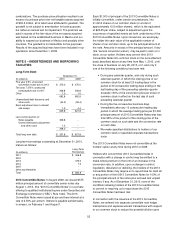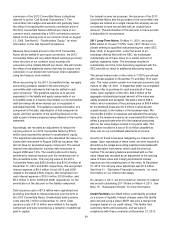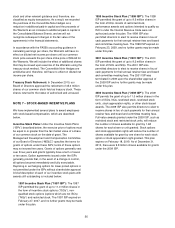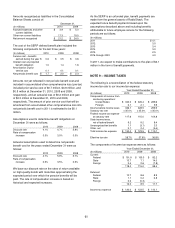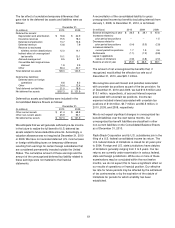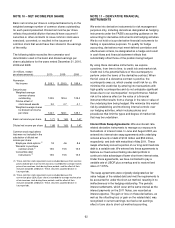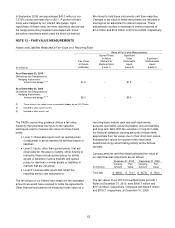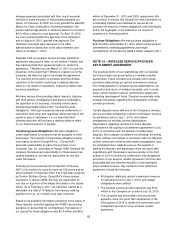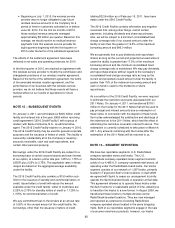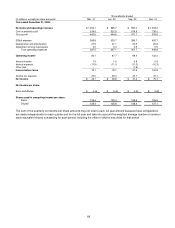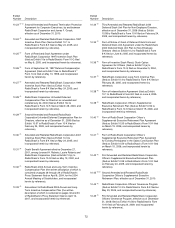Radio Shack 2010 Annual Report Download - page 72
Download and view the complete annual report
Please find page 72 of the 2010 Radio Shack annual report below. You can navigate through the pages in the report by either clicking on the pages listed below, or by using the keyword search tool below to find specific information within the annual report.
62
NOTE 10 – NET INCOME PER SHARE
Basic net income per share is computed based only on the
weighted average number of common shares outstanding
for each period presented. Diluted net income per share
reflects the potential dilution that would have occurred if
securities or other contracts to issue common stock were
exercised, converted, or resulted in the issuance of
common stock that would have then shared in the earnings
of the entity.
The following table reconciles the numerator and
denominator used in the basic and diluted earnings per
share calculations for the years ended December 31, 2010,
2009 and 2008.
(In millions, except
per share amounts)
2010
2009
2008
Numerator:
Net income $ 206.1
$ 205.0 $ 189.4
Denominator:
Weighted-average
common shares
outstanding
120.5
125.4
129.0
Dilutive effect of
stock-based awards
2.2
0.7
0.1
Weighted average shares
for diluted net income
per share
122.7
126.1
129.1
Basic net income per share $ 1.71
$ 1.63
$ 1.47
Diluted net income per share $ 1.68
$ 1.63
$ 1.47
Common stock equivalents
that were not included in the
calculation of diluted net
income per share:
Employee stock options
(1)
1.8
4.6 8.6
Warrants to purchase
common stock (1)
15.5
15.5
15.5
Convertible debt
Instruments (2)
15.5
15.5
15.5
(1)
These common stock equivalents were excluded because their exercise
prices ($36.60 per share for the warrants) exceeded the average market
price of our common stock during these periods, and the effect of their
inclusion would be antidilutive. These securities could be dilutive in
future periods.
(2)
These common stock equivalents were excluded because the
conversion price ($24.25 per share) exceeded the average market price
of our common stock during these periods, and the effect of their
inclusion would be antidilutive. These securities could be dilutive in
future periods.
NOTE 11 – DERIVATIVE FINANCIAL
INSTRUMENTS
We enter into derivative instruments for risk management
purposes only, including derivatives designated as hedging
instruments under the FASB’s accounting guidance on the
accounting for derivative instruments and hedging activities.
We do not hold or issue derivative financial instruments for
trading or speculative purposes. To qualify for hedge
accounting, derivatives must meet defined correlation and
effectiveness criteria, be designated as a hedge and result
in cash flows and financial statement effects that
substantially offset those of the position being hedged.
By using these derivative instruments, we expose
ourselves, from time to time, to credit risk and market risk.
Credit risk is the potential failure of the counterparty to
perform under the terms of the derivative contract. When
the fair value of a derivative contract is positive, the
counterparty owes us, which creates credit risk for us. We
minimize this credit risk by entering into transactions with
high quality counterparties and do not anticipate significant
losses due to our counterparties’ nonperformance. Market
risk is the adverse effect on the value of a financial
instrument that results from a change in the rate or value of
the underlying item being hedged. We minimize this market
risk by establishing and monitoring internal controls over
our hedging activities, which include policies and
procedures that limit the types and degree of market risk
that may be undertaken.
Interest Rate Swap Agreements: We use interest rate-
related derivative instruments to manage our exposure to
fluctuations of interest rates. In June and August 2003, we
entered into interest rate swap agreements with underlying
notional amounts of debt of $100 million and $50 million,
respectively, and both with maturities in May 2011. These
swaps effectively convert a portion of our long-term fixed rate
debt to a variable rate. We entered into these agreements to
balance our fixed versus floating rate debt portfolio to
continue to take advantage of lower short-term interest rates.
Under these agreements, we have contracted to pay a
variable rate of LIBOR plus a markup and to receive fixed
rates of 7.375%.
The swap agreements were originally designated as fair
value hedges of the related debt and met the requirements to
be accounted for under the short-cut method, resulting in no
ineffectiveness in the hedging relationship. The periodic
interest settlements, which occur at the same interval as the
interest payments on the 2011 Notes, are recorded as
interest expense. The gain or loss on these derivatives, as
well as the offsetting loss or gain on the related debt, was
recognized in current earnings, but had a net earnings
effect of zero due to short-cut method accounting.



